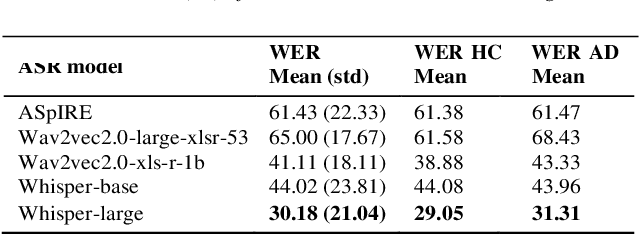Helmer Strik
Reading Miscue Detection in Primary School through Automatic Speech Recognition
Jun 11, 2024Abstract:Automatic reading diagnosis systems can benefit both teachers for more efficient scoring of reading exercises and students for accessing reading exercises with feedback more easily. However, there are limited studies on Automatic Speech Recognition (ASR) for child speech in languages other than English, and limited research on ASR-based reading diagnosis systems. This study investigates how efficiently state-of-the-art (SOTA) pretrained ASR models recognize Dutch native children speech and manage to detect reading miscues. We found that Hubert Large finetuned on Dutch speech achieves SOTA phoneme-level child speech recognition (PER at 23.1\%), while Whisper (Faster Whisper Large-v2) achieves SOTA word-level performance (WER at 9.8\%). Our findings suggest that Wav2Vec2 Large and Whisper are the two best ASR models for reading miscue detection. Specifically, Wav2Vec2 Large shows the highest recall at 0.83, whereas Whisper exhibits the highest precision at 0.52 and an F1 score of 0.52.
Automatic Speech Recognition of Non-Native Child Speech for Language Learning Applications
Jun 29, 2023Abstract:Voicebots have provided a new avenue for supporting the development of language skills, particularly within the context of second language learning. Voicebots, though, have largely been geared towards native adult speakers. We sought to assess the performance of two state-of-the-art ASR systems, Wav2Vec2.0 and Whisper AI, with a view to developing a voicebot that can support children acquiring a foreign language. We evaluated their performance on read and extemporaneous speech of native and non-native Dutch children. We also investigated the utility of using ASR technology to provide insight into the children's pronunciation and fluency. The results show that recent, pre-trained ASR transformer-based models achieve acceptable performance from which detailed feedback on phoneme pronunciation quality can be extracted, despite the challenging nature of child and non-native speech.
* Published on SLATE 2023, Esmad, Politecnico Do Porto, Portugal, 26-28 June, 2023, pp: 11:1-11:8
An ASR-Based Tutor for Learning to Read: How to Optimize Feedback to First Graders
Jun 07, 2023Abstract:The interest in employing automatic speech recognition (ASR) in applications for reading practice has been growing in recent years. In a previous study, we presented an ASR-based Dutch reading tutor application that was developed to provide instantaneous feedback to first-graders learning to read. We saw that ASR has potential at this stage of the reading process, as the results suggested that pupils made progress in reading accuracy and fluency by using the software. In the current study, we used children's speech from an existing corpus (JASMIN) to develop two new ASR systems, and compared the results to those of the previous study. We analyze correct/incorrect classification of the ASR systems using human transcripts at word level, by means of evaluation measures such as Cohen's Kappa, Matthews Correlation Coefficient (MCC), precision, recall and F-measures. We observe improvements for the newly developed ASR systems regarding the agreement with human-based judgment and correct rejection (CR). The accuracy of the ASR systems varies for different reading tasks and word types. Our results suggest that, in the current configuration, it is difficult to classify isolated words. We discuss these results, possible ways to improve our systems and avenues for future research.
* Published (double-blind peer-reviewed) on SPECOM 2021
Automatic Assessment of Oral Reading Accuracy for Reading Diagnostics
Jun 06, 2023Abstract:Automatic assessment of reading fluency using automatic speech recognition (ASR) holds great potential for early detection of reading difficulties and subsequent timely intervention. Precise assessment tools are required, especially for languages other than English. In this study, we evaluate six state-of-the-art ASR-based systems for automatically assessing Dutch oral reading accuracy using Kaldi and Whisper. Results show our most successful system reached substantial agreement with human evaluations (MCC = .63). The same system reached the highest correlation between forced decoding confidence scores and word correctness (r = .45). This system's language model (LM) consisted of manual orthographic transcriptions and reading prompts of the test data, which shows that including reading errors in the LM improves assessment performance. We discuss the implications for developing automatic assessment systems and identify possible avenues of future research.
Alzheimer Disease Classification through ASR-based Transcriptions: Exploring the Impact of Punctuation and Pauses
Jun 06, 2023

Abstract:Alzheimer's Disease (AD) is the world's leading neurodegenerative disease, which often results in communication difficulties. Analysing speech can serve as a diagnostic tool for identifying the condition. The recent ADReSS challenge provided a dataset for AD classification and highlighted the utility of manual transcriptions. In this study, we used the new state-of-the-art Automatic Speech Recognition (ASR) model Whisper to obtain the transcriptions, which also include automatic punctuation. The classification models achieved test accuracy scores of 0.854 and 0.833 combining the pretrained FastText word embeddings and recurrent neural networks on manual and ASR transcripts respectively. Additionally, we explored the influence of including pause information and punctuation in the transcriptions. We found that punctuation only yielded minor improvements in some cases, whereas pause encoding aided AD classification for both manual and ASR transcriptions across all approaches investigated.
 Add to Chrome
Add to Chrome Add to Firefox
Add to Firefox Add to Edge
Add to Edge